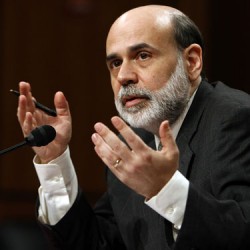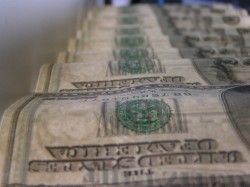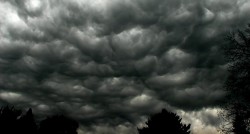 Today the financial world was buzzing with excitement because there was one moderately good piece of news for the U.S. economy. U.S. employers added 151,000 jobs during the month of October and the unemployment rate remained unchanged at 9.6%. This is certainly welcome news, but these days it seems as though there are at least ten pieces of bad economic news for every hopeful economic signal. So don’t get fooled when the U.S. economy takes one step forward, because it is about to take another dozen or so steps backwards. We are living in the middle of a nightmarish long-term economic decline that has been building for generations. The deindustrialization of the United States, the horrific trade deficit caused by globalization and the skyrocketing national debt are problems that have taken decades to develop. The Federal Reserve has been ripping the guts out of our financial system since 1913. These are not things that are going to be fixed overnight. In fact, there are some statistics that just keep getting worse and worse and worse as time goes by. We are heading straight for a devastating economic collapse and hopefully we can all warn as many people as possible while there is still time. (Read More...)
Today the financial world was buzzing with excitement because there was one moderately good piece of news for the U.S. economy. U.S. employers added 151,000 jobs during the month of October and the unemployment rate remained unchanged at 9.6%. This is certainly welcome news, but these days it seems as though there are at least ten pieces of bad economic news for every hopeful economic signal. So don’t get fooled when the U.S. economy takes one step forward, because it is about to take another dozen or so steps backwards. We are living in the middle of a nightmarish long-term economic decline that has been building for generations. The deindustrialization of the United States, the horrific trade deficit caused by globalization and the skyrocketing national debt are problems that have taken decades to develop. The Federal Reserve has been ripping the guts out of our financial system since 1913. These are not things that are going to be fixed overnight. In fact, there are some statistics that just keep getting worse and worse and worse as time goes by. We are heading straight for a devastating economic collapse and hopefully we can all warn as many people as possible while there is still time. (Read More...)
Caught In A Lie: Bernanke Promised Congress The Federal Reserve Would Not Monetize The Debt But Now That Is Exactly What Is Happening
 On June 3rd, 2009 Federal Reserve Chairman Ben Bernanke promised the U.S. Congress that the Federal Reserve would not monetize the debt of the U.S. government. On November 3rd, 2010 the Federal Reserve announced a massive quantitative easing plan which will involve the purchase of 600 billion dollars of U.S. Treasury securities by the middle of 2011. Creating 600 billion dollars out of thin air and using them to buy up U.S. government securities is monetizing the debt. So Federal Reserve Chairman Ben Bernanke has been caught in a lie. Will we ever be able to trust a single word that he says ever again? (Read More...)
On June 3rd, 2009 Federal Reserve Chairman Ben Bernanke promised the U.S. Congress that the Federal Reserve would not monetize the debt of the U.S. government. On November 3rd, 2010 the Federal Reserve announced a massive quantitative easing plan which will involve the purchase of 600 billion dollars of U.S. Treasury securities by the middle of 2011. Creating 600 billion dollars out of thin air and using them to buy up U.S. government securities is monetizing the debt. So Federal Reserve Chairman Ben Bernanke has been caught in a lie. Will we ever be able to trust a single word that he says ever again? (Read More...)
9 Reasons Why Quantitative Easing Is Bad For The U.S. Economy
 Buckle up and hold on – a new round of quantitative easing is here and things could start getting very ugly in the financial world over the coming months. The truth is that many economists fear that an out of control Federal Reserve is “crossing the Rubicon” by announcing another wave of quantitative easing. Have we now reached a point where the Federal Reserve is simply going to fire up the printing presses and shower massive wads of cash into the financial system whenever the U.S. economy is not growing fast enough? If so, what does the mean for inflation, the stability of the world financial system and the future of the U.S. dollar? The Fed says that the plan is to purchase $600 billion of U.S. Treasury securities by the middle of 2011. In addition, the Federal Reserve has announced that it will be “reinvesting” an additional $250 billion to $300 billion from the proceeds of its mortgage portfolio in U.S. Treasury securities over the same time period. So that is a total injection of about $900 billion. Perhaps the Fed thought that number would sound a little less ominous than $1 trillion. In any event, the Federal Reserve seems convinced that quantitative easing is going to work this time. So should we believe the Federal Reserve? (Read More...)
Buckle up and hold on – a new round of quantitative easing is here and things could start getting very ugly in the financial world over the coming months. The truth is that many economists fear that an out of control Federal Reserve is “crossing the Rubicon” by announcing another wave of quantitative easing. Have we now reached a point where the Federal Reserve is simply going to fire up the printing presses and shower massive wads of cash into the financial system whenever the U.S. economy is not growing fast enough? If so, what does the mean for inflation, the stability of the world financial system and the future of the U.S. dollar? The Fed says that the plan is to purchase $600 billion of U.S. Treasury securities by the middle of 2011. In addition, the Federal Reserve has announced that it will be “reinvesting” an additional $250 billion to $300 billion from the proceeds of its mortgage portfolio in U.S. Treasury securities over the same time period. So that is a total injection of about $900 billion. Perhaps the Fed thought that number would sound a little less ominous than $1 trillion. In any event, the Federal Reserve seems convinced that quantitative easing is going to work this time. So should we believe the Federal Reserve? (Read More...)
The Federal Reserve Is Holding A Conference On Jekyll Island To Celebrate 100 Years Of Dominating America: “A Return to Jekyll Island: The Origins, History, and Future of the Federal Reserve”
 The Federal Reserve is going back to Jekyll Island to celebrate the 100 year anniversary of the infamous 1910 Jekyll Island meeting that spawned the draft legislation that would ultimately create the U.S. Federal Reserve. The title of this conference is “A Return to Jekyll Island: The Origins, History, and Future of the Federal Reserve”, and it will be held on November 5th and 6th in the exact same building where the original 1910 meeting occurred. In November 1910, the original gathering at Jekyll Island included U.S. Senator Nelson W. Aldrich, Assistant Secretary of the Treasury Department A.P. Andrews and many representatives from the upper crust of the U.S. banking establishment. That meeting was held in an environment of absolute and total secrecy. 100 years later, Federal Reserve bureaucrats will return to Jekyll Island once again to “celebrate” the history and the future of the Federal Reserve. (Read More...)
The Federal Reserve is going back to Jekyll Island to celebrate the 100 year anniversary of the infamous 1910 Jekyll Island meeting that spawned the draft legislation that would ultimately create the U.S. Federal Reserve. The title of this conference is “A Return to Jekyll Island: The Origins, History, and Future of the Federal Reserve”, and it will be held on November 5th and 6th in the exact same building where the original 1910 meeting occurred. In November 1910, the original gathering at Jekyll Island included U.S. Senator Nelson W. Aldrich, Assistant Secretary of the Treasury Department A.P. Andrews and many representatives from the upper crust of the U.S. banking establishment. That meeting was held in an environment of absolute and total secrecy. 100 years later, Federal Reserve bureaucrats will return to Jekyll Island once again to “celebrate” the history and the future of the Federal Reserve. (Read More...)
Living Beyond Our Means: 3 Charts That Prove That We Are In The Biggest Debt Bubble In The History Of The World
 Do you want to see something truly frightening? Just check out the 3 charts posted further down in this article. These charts prove that we are now in the biggest debt bubble in the history of the world. As Americans have enjoyed an incredibly wonderful standard of living over the past three decades, most of them have believed that it was because we are the wealthiest, most prosperous nation on the planet with economic and financial systems that are second to none. But that is not even close to accurate. The reason why we have had an almost unbelievably high standard of living over the past three decades is because we have piled up the biggest mountains of debt in the history of the world. Once upon a time the United States was the wealthiest country on the planet, but all of that prosperity was not good enough for us. So we started borrowing and borrowing and borrowing and we have now been living beyond our means for so long that we consider it to be completely normal. (Read More...)
Do you want to see something truly frightening? Just check out the 3 charts posted further down in this article. These charts prove that we are now in the biggest debt bubble in the history of the world. As Americans have enjoyed an incredibly wonderful standard of living over the past three decades, most of them have believed that it was because we are the wealthiest, most prosperous nation on the planet with economic and financial systems that are second to none. But that is not even close to accurate. The reason why we have had an almost unbelievably high standard of living over the past three decades is because we have piled up the biggest mountains of debt in the history of the world. Once upon a time the United States was the wealthiest country on the planet, but all of that prosperity was not good enough for us. So we started borrowing and borrowing and borrowing and we have now been living beyond our means for so long that we consider it to be completely normal. (Read More...)
The Calm Before The Storm
 An eerie calm has descended upon world financial markets as they await perhaps the two most important financial events of the year this week. On Tuesday, investors will be eagerly awaiting the results of one of the most anticipated midterm elections in U.S. history. On Wednesday, the Federal Reserve is expected to end months of speculation by formally announcing the details of a new round of quantitative easing. If either the election or the meeting of the Federal Reserve open market committee delivers a highly unexpected result, it could have a dramatic impact on world financial markets. In fact, many are looking at this week as a potential turning point for the U.S. economy. The decisions that are made or not made this week could set us down a road from which the U.S. economy may never recover. (Read More...)
An eerie calm has descended upon world financial markets as they await perhaps the two most important financial events of the year this week. On Tuesday, investors will be eagerly awaiting the results of one of the most anticipated midterm elections in U.S. history. On Wednesday, the Federal Reserve is expected to end months of speculation by formally announcing the details of a new round of quantitative easing. If either the election or the meeting of the Federal Reserve open market committee delivers a highly unexpected result, it could have a dramatic impact on world financial markets. In fact, many are looking at this week as a potential turning point for the U.S. economy. The decisions that are made or not made this week could set us down a road from which the U.S. economy may never recover. (Read More...)
Why Is Indiana Putting Armed Security Guards Into 36 Unemployment Offices Across The State?
 Did you ever think that things in America would get so bad that we would need to put armed guards into our unemployment offices? Well, that is exactly what is happening in Indiana. Armed security guards will now be posted at all 36 full-service unemployment offices in the state of Indiana. So why is this happening now? Well, Indiana Department of Workforce Development spokesman Marc Lotter says that the agency is bringing in the extra security in anticipation of an upcoming deadline when thousands upon thousands of Indiana residents could have their unemployment benefits cut off. But it is not just the state of Indiana that could have a problem. In fact, one recent study found that approximately 2 million Americans will lose their unemployment insurance benefits during this upcoming holiday season unless Congress authorizes another emergency extension of benefits by the end of November. At this point, however, that is looking less and less likely. (Read More...)
Did you ever think that things in America would get so bad that we would need to put armed guards into our unemployment offices? Well, that is exactly what is happening in Indiana. Armed security guards will now be posted at all 36 full-service unemployment offices in the state of Indiana. So why is this happening now? Well, Indiana Department of Workforce Development spokesman Marc Lotter says that the agency is bringing in the extra security in anticipation of an upcoming deadline when thousands upon thousands of Indiana residents could have their unemployment benefits cut off. But it is not just the state of Indiana that could have a problem. In fact, one recent study found that approximately 2 million Americans will lose their unemployment insurance benefits during this upcoming holiday season unless Congress authorizes another emergency extension of benefits by the end of November. At this point, however, that is looking less and less likely. (Read More...)
5 Dangers To Global Crops That Could Dramatically Reduce The World Food Supply
 The world food situation is starting to get very, very tight. Unprecedented heat and wildfires this summer in Russia and horrific flooding in Pakistan and China have been some of the primary reasons for the rapidly rising food prices we are now seeing around the globe. In places such as Australia and the African nation of Guinea-Bissau, the big problem for crops has been locusts. In a world that already does not grow enough food for everyone (thanks to the greed of the elite), any disruption in food production can cause a major, major problem. Tonight, thousands of people around the world will starve to death. So what happens if things get even worse? Many agricultural scientists are now warning that global food production is facing dangers that are absolutely unprecedented. Crop diseases such as UG99 wheat rust and the “unintended effects” of genetic modification pose challenges that previous generations simply did not have to face. The outbreak of a real, live global famine looks increasingly possible with each passing year. So are you and your family prepared if a global famine does strike? (Read More...)
The world food situation is starting to get very, very tight. Unprecedented heat and wildfires this summer in Russia and horrific flooding in Pakistan and China have been some of the primary reasons for the rapidly rising food prices we are now seeing around the globe. In places such as Australia and the African nation of Guinea-Bissau, the big problem for crops has been locusts. In a world that already does not grow enough food for everyone (thanks to the greed of the elite), any disruption in food production can cause a major, major problem. Tonight, thousands of people around the world will starve to death. So what happens if things get even worse? Many agricultural scientists are now warning that global food production is facing dangers that are absolutely unprecedented. Crop diseases such as UG99 wheat rust and the “unintended effects” of genetic modification pose challenges that previous generations simply did not have to face. The outbreak of a real, live global famine looks increasingly possible with each passing year. So are you and your family prepared if a global famine does strike? (Read More...)